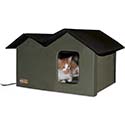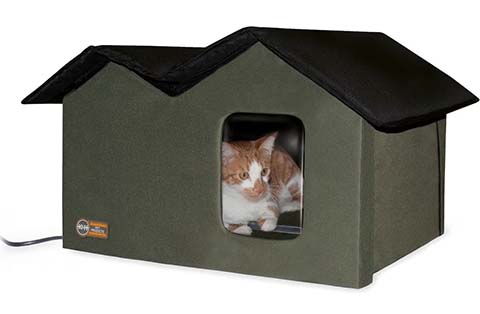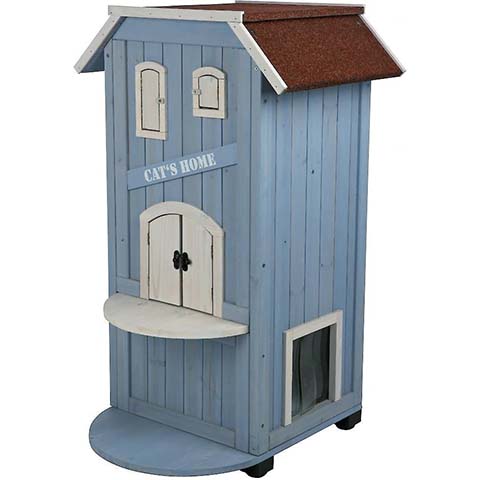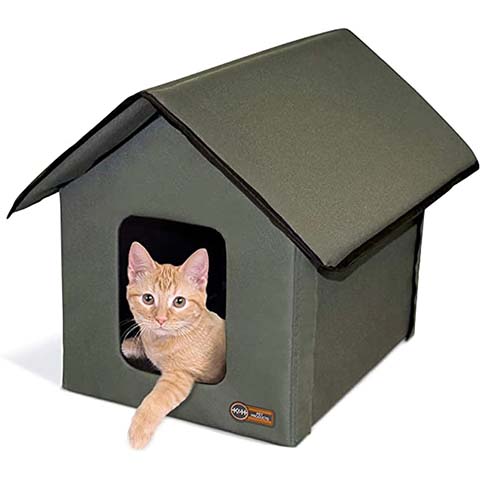
However, not all houses are made the same. Some are well-constructed, while others won’t last long in a storm. There are heated cat houses, which are great for cold places but less great if you live in Texas! Some outdoor cat houses are extremely basic, and others have a plethora of features.
Here, we help you find the best outdoor cat house for your feline. Read on for a list of reviews so you can figure out which one your feline may like.
A Quick Comparison of Our Favorites in 2024
| Image | Product | Details | ||
|---|---|---|---|---|
| Best Overall |

|
New Age Pet ECOFLEX Outdoor Cat House Shelter |
|
CHECK PRICE |
| Best Value |

|
Trixie Outdoor Wooden Cat House |
|
CHECK PRICE |
| Premium Choice |

|
K&H Pet Products Outdoor Heated Cat House Extra-Wide |
|
CHECK PRICE |

|
Frisco Outdoor Wooden Cat House With Elevated Balcony Steps |
|
CHECK PRICE | |

|
TRIXIE 3-Story Outdoor Wooden Cat House |
|
CHECK PRICE |
The 10 Best Outdoor Cat Houses
1. New Age Pet ECOFLEX Outdoor Cat House Shelter — Best Overall

| Material: | Wood plastic composite |
| Assembly Required: | Yes |
The New Age Pet ECOFLEX Outdoor Cat House Shelter is the best overall outdoor cat house. It’s made from a durable material that’s long-lasting, even against the outdoor elements. It features two entry points so your cat always has an escape route. Many cats feel safer with two entries, as it helps them get out if something sneaks up on them.
This house does require some assembly. However, no tools are required. The elevated floor provides flow-through ventilation, ensuring that condensation doesn’t build up inside the cat house. It also helps keep the inside cool.
We particularly like the two vinyl door flaps. These provide added protection against all sorts of weather, which is often essential during heavier storms.
- Easy assembly
- Long-lasting materials
- Ventilated
- Two entrances
- Two vinyl door flaps
- Top does not lift up
2. Trixie Outdoor Wooden Cat House — Best Value

| Material: | Wood |
| Assembly Required: | Yes |
The Trixie Outdoor Wooden Cat House is made from weather-treated pine that is durable and natural-looking. It’s made to ensure years of use with little maintenance. The elevated foundation ensures that your pet is protected from ground chill and wet conditions (as well as the wood, which would be prone to rotting if it sat in a puddle).
The roof is made with composite asphalt, which helps with durability. The roof can also open up if necessary, and the floor is removable for easy cleaning. The front door folds down and turns into a ramp. When it isn’t in use, you can fold it up and latch it, which makes storage much more straightforward.
This whole unit can be put together in less than 15 minutes and includes all the necessary tools. Plus, it’s much cheaper than most cat houses, making it the best outdoor cat house for the money.
- Inexpensive
- Easy storage due to the latching door
- Durable due to wood and asphalt construction
- Lifted floor
- Only one entrance
3. K&H Pet Products Outdoor Heated Cat House Extra-Wide — Premium Choice

| Material: | Vinyl and 600D nylon |
| Assembly Required: | Yes |
The K&H Pet Products Outdoor Heated Cat House Extra-Wide is interesting. First, it’s held together using Velcro, which makes it easy to put together. It’s also made from 600D nylon, which is a rare material in the outdoor cat house world.
It is more expensive than most other options, but that’s because it’s heated. It’s quite large and can house many cats at once in poor weather conditions. It’s perfect for outdoor cat colonies or other groups of cats. Anywhere your cat needs additional warmth, this house can be used. It can even be used indoors if your cat loves heated houses.
There are two exits built into the house with removable door flaps. You can use the door flaps or not (a useful feature if your cat refuses to use door flaps). Your cat won’t be trapped by predators due to the double entrance.
- Heated
- Large enough to protect several cats
- Two entrances to provide an escape route
- Durable construction
- Expensive
4. Frisco Outdoor Wooden Cat House With Elevated Balcony Steps

| Material: | Wood |
| Assembly Required: | Yes |
We like the Frisco Outdoor Wooden Cat House With Elevated Balcony Steps for several reasons. The balcony is a nice touch, and it appears that many cats do like to use it. It’s also more aesthetically pleasing than many other outdoor cat houses, so it will look great in your yard.
The raised floor provides adequate ventilation and keeps the house off of the floor. The elevated steps make it easy for your cat to enter, though, even if they are older. The whole thing is made with solid wood and uses metal to keep it together.
Sadly, this unit doesn’t appear to be as well-made as some other options. Therefore, it probably won’t last that long.
- Raised floors for ventilation
- Cute design
- Wood and metal materials
- Not that durable
5. TRIXIE 3-Story Outdoor Wooden Cat House

| Material: | Wood |
| Assembly Required: | Yes |
The TRIXIE 3-Story Outdoor Wooden Cat House has a modern design and is quite tall. It’s three stories, giving your cat plenty of room to explore and play. However, it’s a bit more complicated than some other cat houses and harder to assemble. Plus, many cats may not like the lack of two entrances on each floor. It’s nice to look at, but it probably won’t be as practical for these reasons.
With that said, it does seem durable. It’s made from treated wood that’s designed to stand up to outdoor conditions. The bottom of the floor is raised to provide adequate airflow. It even has plastic flaps to provide extra protection from the wind and rain.
- Aesthetically pleasing
- Durable
- Raised floors provide airflow
- Expensive
- Complex design
6. Frisco Outdoor Wooden Cat House With Retractable Roof

| Material: | Wood and PVC |
| Assembly Required: | Yes |
The Frisco Outdoor Wooden Cat House With Retractable Roof is a simple cat house. It’s made similarly to a traditional dog house, only cat sized. Therefore, it’s great for those who just want something simple and straightforward. It works, but it isn’t going to blow you away with any fancy features.
There is only one entrance, but it is covered by a plastic flap. The roof retracts if you need to get inside the house for cleaning. The floor is also raised, which helps preserve the wood and keep your cat off the ground. The roof is made from PVC and slanted to help water run down. This feature stands out from other cat houses, which may have trouble with snow caving in their roof.
Sadly, this house doesn’t seem to be that durable. The wood is somewhat lower quality than many other options on the market.
- Raised floors for ventilation
- Durable, slanted roof
- Small and simple
- Only one door
- Low-quality wood
7. K&H Pet Products Outdoor Kitty House

| Material: | Vinyl and 600D nylon |
| Assembly Required: | Yes |
The K&H Pet Products Outdoor Kitty House is a simplified version of the premium choice on this list. It isn’t heated, but not all cats need a heated cat house. It features two exits, which is important when choosing a cat house. You don’t want your cat to get trapped by another cat or a predator (plus, many cats just won’t use a shelter with an entrance).
It’s easy to clean and made out of nylon and vinyl. There isn’t any wood here, unlike most of the other cat houses available. The construction is water resistant, and the whole thing is kept together using Velcro. It’s easy to put together, store, and clean.
Sadly, this house is extremely small. It will only hold one feline, and it likely won’t provide tons of protection. Its cheap cost may still make it worth it, though.
- Water-resistant material
- Two exits
- Durable materials for a long-lasting house
- Small
- Not raised, causing poor ventilation
8. Frisco Outdoor Wooden A-Frame Cat House

| Material: | Wood |
| Assembly Required: | Yes |
It doesn’t get much cuter than the Frisco Outdoor Wooden A-Frame Cat House. It has a unique A-frame design that makes it stand out. It’ll look good in practically any yard and has a modern design. However, you are paying for this design, as it is more expensive than many other houses while also being smaller. Therefore, you’re getting much less space per dollar.
The triangular frame does allow the house to stand up to the weather. The double entrance works well for concerned cats, and the flaps help keep cold air and rain out of the house. Two different sizes are available so you can choose the perfect option for your cat colony.
With that said, the wood isn’t the highest quality, according to many cat owners. Therefore, while it is cute, it probably isn’t as practical as some other options.
- Cute triangular frame
- Two entrances to provide an escape route
- Plastic flaps to keep the inside protected
- Low-quality wood
- Expensive
9. TRIXIE 2-Story Cottage Outdoor Wooden Cat House

| Material: | Wood |
| Assembly Required: | Yes |
We typically love the Trixie brand when it comes to cat houses, and the TRIXIE 2-Story Cottage Outdoor Wooden Cat House is no different. It’s an adorable cat house with two stories, a large entrance, and several windows. It’s even made from weather-treated fir wood, which gives it a premium vibe. The wood also happens to be quite durable, which is a necessary feature.
With that said, this house is extremely expensive. It’s twice the cost of most other houses. While some of this is due to the size, even when you consider the two-story feature, it’s still more expensive than the competition. Plus, there isn’t much keeping the doors open. Therefore, in high winds, they’re liable to slam open and shut (which cats probably won’t like that much).
Simply put, this house is cute but it isn’t the most practical.
- Large two-story design
- Several entrances to accommodate several cats
- Raised floors to prevent decay
- Expensive
- Not the most practical option
10. Petsfit Outdoor Cat House With Scratching Pad

| Material: | Wood |
| Assembly Required: | Yes |
The Petsfit Outdoor Cat House With Scratching Pad has a bit of a strange design, especially compared to some of the more modern cat houses on this list. However, the house is spacious enough for one to three cats (up to 18 pounds each). The asphalt roof has a raised design that can help keep your kitties dry in wet weather, and it extends past the base. While this does make the house look odd, it will keep your feline dry.
There is a front door and an escape door under the ladder, which makes it easy for your cat to come and go. The upper-level balcony provides extra room for your cat to lie around and watch the birds.
This house is quite expensive, though, especially since it isn’t much larger than many other houses. In fact, we found it to be significantly smaller than most, even with the added balcony on top.
- Large roof helps keep your cat dry
- Two entrances
- Expensive
- Smaller than most other houses
Buyer’s Guide: Choosing the Best Outdoor House for Your Cat
Choosing a cat house can seem a bit complicated. However, with a basic understanding of the possible features, you can easily pick out a house that works best for your feline.
Heated vs. Unheated
If you live somewhere that gets very cold, you may want to consider getting a heated cat house. Often, houses packed with something like straw are enough to keep many cats warm. However, if it regularly drops a lot below freezing, having a house that produces heat may be essential. Most heated houses must be plugged into a power source. Therefore, they work best when kept close to the house or inside a barn.
Heated cat houses also have more parts that can break, which often limits their lifespan. However, if you live somewhere very cold, that might not matter much. Sometimes, your cat simply needs a heated house.
Size
The size of cat house that you choose largely depends on the cats that you have. If you have many cats, you’ll need a bigger house (or several). Large cats also need more room, as you’d probably guess.
However, bigger isn’t always better. A large house can make it harder for your cat to “heat” it. More air inside the insulated house means a longer time between your cat entering and their body heat making a difference in the internal temperature. Therefore, you do want their house to be a bit snug.
The size of houses can be a bit misleading based on the pictures. Therefore, we recommend looking at the listed dimensions. You might be surprised by how little or big a certain house is. The images don’t always do them justice.
Also, consider how many stories the house is, and understand that all cats won’t use every story. Some will only use the bottom story, especially if the door to get upstairs is inside.
Durability
You want your cat’s house to be durable. However, durability can be complicated, as it’s affected by many different things. The material has a huge role, of course. Treated wood, vinyl, and plastic are often the most durable. However, the quality of the material also matters.
The easiest way to determine a house’s durability is to look at reviews. They will let you know how durable the product is in a real-world setting, which can be hard to determine by looking at the description. However, some houses are less durable than others. Houses that don’t look well put together often aren’t.
Safety
The house should be safe for your cat. This means using only cat-safe materials, and the wood used shouldn’t contain tons of chemicals. Safe glue should also be used. Remember, cats lick their coats when grooming. Therefore, anything that they come into contact with could end up being ingested. Your cat doesn’t have to literally eat the wood to ingest any chemicals that are in it.
The house should also have at least two doors. This is for two different reasons. First, your cat should always have an escape route in case a predator or another cat shows up. The last thing you want is for a predator to be blocking the only doorway and your cat to be stuck inside. Second, cats know this. Their natural instinct is to choose hiding places with multiple entrances, just in case a foe shows up. Therefore, many cats won’t use a house if it only has a single door.
Conclusion
There are tons of different outdoor cat houses that can keep your feline dry and warm. Among these reviews, we recommend the New Age Pet Ecoflex Outdoor Cat House. It’s well-ventilated, has two entrances, and is durable. It works well for many cats, as long as you don’t need a heated cat house. Trixie Outdoor Wooden Cat House also works well despite being quite a bit less expensive than many other options.
If you need a heated house, the K&H Pet Products Outdoor Heated Kitty House is ideal. It is a bit expensive, but since it’s heated, it’s worth the extra cost.
Featured Image Credit: Alexas_Fotos, Pixabay
Contents
- A Quick Comparison of Our Favorites in 2024
- The 10 Best Outdoor Cat Houses
- 1. New Age Pet ECOFLEX Outdoor Cat House Shelter — Best Overall
- 2. Trixie Outdoor Wooden Cat House — Best Value
- 3. K&H Pet Products Outdoor Heated Cat House Extra-Wide — Premium Choice
- 4. Frisco Outdoor Wooden Cat House With Elevated Balcony Steps
- 5. TRIXIE 3-Story Outdoor Wooden Cat House
- 6. Frisco Outdoor Wooden Cat House With Retractable Roof
- 7. K&H Pet Products Outdoor Kitty House
- 8. Frisco Outdoor Wooden A-Frame Cat House
- 9. TRIXIE 2-Story Cottage Outdoor Wooden Cat House
- 10. Petsfit Outdoor Cat House With Scratching Pad
- Buyer’s Guide: Choosing the Best Outdoor House for Your Cat
- Conclusion














